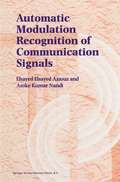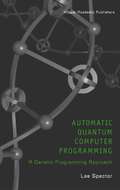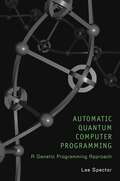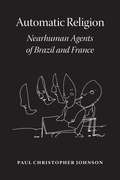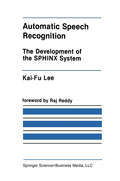- Table View
- List View
Automatic Modulation Classification: Principles, Algorithms and Applications
by Zhechen Zhu Asoke K. NandiAutomatic Modulation Classification (AMC) has been a key technology in many military, security, and civilian telecommunication applications for decades. In military and security applications, modulation often serves as another level of encryption; in modern civilian applications, multiple modulation types can be employed by a signal transmitter to control the data rate and link reliability. This book offers comprehensive documentation of AMC models, algorithms and implementations for successful modulation recognition. It provides an invaluable theoretical and numerical comparison of AMC algorithms, as well as guidance on state-of-the-art classification designs with specific military and civilian applications in mind. Key Features: Provides an important collection of AMC algorithms in five major categories, from likelihood-based classifiers and distribution-test-based classifiers to feature-based classifiers, machine learning assisted classifiers and blind modulation classifiers Lists detailed implementation for each algorithm based on a unified theoretical background and a comprehensive theoretical and numerical performance comparison Gives clear guidance for the design of specific automatic modulation classifiers for different practical applications in both civilian and military communication systems Includes a MATLAB toolbox on a companion website offering the implementation of a selection of methods discussed in the book
Automatic Modulation Recognition of Communication Signals
by Elsayed Azzouz A.K. NandiAutomatic modulation recognition is a rapidly evolving area of signal analysis. In recent years, interest from the academic and military research institutes has focused around the research and development of modulation recognition algorithms. Any communication intelligence (COMINT) system comprises three main blocks: receiver front-end, modulation recogniser and output stage. Considerable work has been done in the area of receiver front-ends. The work at the output stage is concerned with information extraction, recording and exploitation and begins with signal demodulation, that requires accurate knowledge about the signal modulation type. There are, however, two main reasons for knowing the current modulation type of a signal; to preserve the signal information content and to decide upon the suitable counter action, such as jamming. Automatic Modulation Recognition of Communications Signals describes in depth this modulation recognition process. Drawing on several years of research, the authors provide a critical review of automatic modulation recognition. This includes techniques for recognising digitally modulated signals. The book also gives comprehensive treatment of using artificial neural networks for recognising modulation types. Automatic Modulation Recognition of Communications Signals is the first comprehensive book on automatic modulation recognition. It is essential reading for researchers and practising engineers in the field. It is also a valuable text for an advanced course on the subject.
Automatic Nonuniform Random Variate Generation (Statistics and Computing)
by Wolfgang Hörmann Josef Leydold Gerhard DerflingerThe recent concept of universal (also called automatic or black-box) random variate generation can only be found dispersed in the literature. Being unique in its overall organization, the book covers not only the mathematical and statistical theory but also deals with the implementation of such methods. All algorithms introduced in the book are designed for practical use in simulation and have been coded and made available by the authors. Examples of possible applications of the presented algorithms (including option pricing, VaR and Bayesian statistics) are presented at the end of the book.
The Automatic Packaging Machinery Sector in Italy and Germany (SpringerBriefs in Business)
by Marco Fortis Monica CarminatiThis book analyzes the wrapping and packaging machinery sector in the Emilia/Bologna district in Italy and compares the most recent trends with those in the industry in Schwäbisch Hall and Waiblingen, Baden-Württemberg, Germany, which represents a direct rival. In a detailed and original study, the authors trace the evolution of manufacturing in Bologna during a period that witnessed extraordinary growth in automatic wrapping and packaging machines, leading the sector to become a central pillar of Italian mechanical engineering. Similarly, the history of the industry in the Emilia district is described, highlighting the factors that led to its success. A comprehensive comparative analysis of the German and Italian sectors is then performed. Export figures and the trade balance for the sector are examined based on Eurostat data, and the significance of the two districts in terms of global trade is identified with reference to UN data. In addition, the number of companies, sales, and the size of the workforces are thoroughly compared. The book will be of interest to economists and others with an interest in the development and importance of the automatic packaging machinery sector.
Automatic Parallelization: New Approaches to Code Generation, Data Distribution, and Performance Prediction
by Christoph W. KesslerDistributed-memory multiprocessing systems (DMS), such as Intel's hypercubes, the Paragon, Thinking Machine's CM-5, and the Meiko Computing Surface, have rapidly gained user acceptance and promise to deliver the computing power required to solve the grand challenge problems of Science and Engineering. These machines are relatively inexpensive to build, and are potentially scalable to large numbers of processors. However, they are difficult to program: the non-uniformity of the memory which makes local accesses much faster than the transfer of non-local data via message-passing operations implies that the locality of algorithms must be exploited in order to achieve acceptable performance. The management of data, with the twin goals of both spreading the computational workload and minimizing the delays caused when a processor has to wait for non-local data, becomes of paramount importance. When a code is parallelized by hand, the programmer must distribute the program's work and data to the processors which will execute it. One of the common approaches to do so makes use of the regularity of most numerical computations. This is the so-called Single Program Multiple Data (SPMD) or data parallel model of computation. With this method, the data arrays in the original program are each distributed to the processors, establishing an ownership relation, and computations defining a data item are performed by the processors owning the data.
Automatic Parallelization: An Overview of Fundamental Compiler Techniques (Synthesis Lectures on Computer Architecture)
by Samuel MidkiffCompiling for parallelism is a longstanding topic of compiler research. This book describes the fundamental principles of compiling "regular" numerical programs for parallelism. We begin with an explanation of analyses that allow a compiler to understand the interaction of data reads and writes in different statements and loop iterations during program execution. These analyses include dependence analysis, use-def analysis and pointer analysis. Next, we describe how the results of these analyses are used to enable transformations that make loops more amenable to parallelization, and discuss transformations that expose parallelism to target shared memory multicore and vector processors. We then discuss some problems that arise when parallelizing programs for execution on distributed memory machines. Finally, we conclude with an overview of solving Diophantine equations and suggestions for further readings in the topics of this book to enable the interested reader to delve deeper into the field. Table of Contents: Introduction and overview / Dependence analysis, dependence graphs and alias analysis / Program parallelization / Transformations to modify and eliminate dependences / Transformation of iterative and recursive constructs / Compiling for distributed memory machines / Solving Diophantine equations / A guide to further reading
Automatic Performance Prediction of Parallel Programs
by Thomas FahringerAutomatic Performance Prediction of Parallel Programs presents a unified approach to the problem of automatically estimating the performance of parallel computer programs. The author focuses primarily on distributed memory multiprocessor systems, although large portions of the analysis can be applied to shared memory architectures as well. The author introduces a novel and very practical approach for predicting some of the most important performance parameters of parallel programs, including work distribution, number of transfers, amount of data transferred, network contention, transfer time, computation time and number of cache misses. This approach is based on advanced compiler analysis that carefully examines loop iteration spaces, procedure calls, array subscript expressions, communication patterns, data distributions and optimizing code transformations at the program level; and the most important machine specific parameters including cache characteristics, communication network indices, and benchmark data for computational operations at the machine level. The material has been fully implemented as part of P3T, which is an integrated automatic performance estimator of the Vienna Fortran Compilation System (VFCS), a state-of-the-art parallelizing compiler for Fortran77, Vienna Fortran and a subset of High Performance Fortran (HPF) programs. A large number of experiments using realistic HPF and Vienna Fortran code examples demonstrate highly accurate performance estimates, and the ability of the described performance prediction approach to successfully guide both programmer and compiler in parallelizing and optimizing parallel programs. A graphical user interface is described and displayed that visualizes each program source line together with the corresponding parameter values. P3T uses color-coded performance visualization to immediately identify hot spots in the parallel program. Performance data can be filtered and displayed at various levels of detail. Colors displayed by the graphical user interface are visualized in greyscale. Automatic Performance Prediction of Parallel Programs also includes coverage of fundamental problems of automatic parallelization for distributed memory multicomputers, a description of the basic parallelization strategy and a large variety of optimizing code transformations as included under VFCS.
Automatic Processing of Natural-Language Electronic Texts with NooJ: 10th International Conference, NooJ 2016, České Budějovice, Czech Republic, June 9-11, 2016, Revised Selected Papers (Communications in Computer and Information Science #667)
by Linda Barone Mario Monteleone Max SilberzteinThis book constitutes the refereed proceedings of the 10th International Conference, NooJ 2016, held České Budějovice, Czech Republic, in June 2016.The 21 revised full papers presented in this volume were carefully reviewed and selected from 45 submissions. NooJ is a linguistic development environment that provides tools for linguists to construct linguistic resources that formalise a large gamut of linguistic phenomena: typography, orthography, lexicons for simple words, multiword units and discontinuous expressions, inflectional and derivational morphology, local, structural and transformational syntax, and semantics.
Automatic Processing of Natural-Language Electronic Texts with NooJ: 9th International Conference, NooJ 2015, Minsk, Belarus, June 11-13, 2015, Revised Selected Papers (Communications in Computer and Information Science #607)
by Tatsiana Okrut Yuras Hetsevich Max Silberztein Hanna StanislavenkaThis book constitutes the refereed proceedings of the 9th International Conference, NooJ 2015, held in Minsk, Belarus, in June 2015.NooJ 2015 received 51 submissions. The 20 revised full papers presented in this volume were carefully reviewed and selected from the 35 papers that were presented at the conference. The papers are organized in topical sections on corpora, vocabulary and morphology; syntax and semantics; application.
Automatic Program Development: A Tribute to Robert Paige
by Olivier Danvy Fritz Henglein Harry Mairson Alberto PettorossiThis work, a tribute to renowned researcher Robert Paige, is a collection of revised papers published in his honor in the Higher-Order and Symbolic Computation Journal in 2003 and 2005. Among them there are two key papers: a retrospective view of his research lines, and a proposal for future studies in the area of the automatic program derivation. The book also includes some papers by members of the IFIP Working Group 2.1 of which Bob was an active member.
Automatic Programming Applied to VLSI CAD Software: A Case Study (The Springer International Series in Engineering and Computer Science #101)
by Dorothy E. Setliff Rob A. RutenbarThis book, and the research it describes, resulted from a simple observation we made sometime in 1986. Put simply, we noticed that many VLSI design tools looked "alike". That is, at least at the overall software architecture level, the algorithms and data structures required to solve problem X looked much like those required to solve problem X'. Unfortunately, this resemblance is often of little help in actually writing the software for problem X' given the software for problem X. In the VLSI CAD world, technology changes rapidly enough that design software must continually strive to keep up. And of course, VLSI design software, and engineering design software in general, is often exquisitely sensitive to some aspects of the domain (technology) in which it operates. Modest changes in functionality have an unfortunate tendency to require substantial (and time-consuming) internal software modifications. Now, observing that large engineering software systems are technology dependent is not particularly clever. However, we believe that our approach to xiv Preface dealing with this problem took an interesting new direction. We chose to investigate the extent to which automatic programming ideas cold be used to synthesize such software systems from high-level specifications. This book is one of the results of that effort.
Automatic Quantum Computer Programming: A Genetic Programming Approach (Genetic Programming #7)
by Lee SpectorAutomatic Quantum Computer Programming provides an introduction to quantum computing for non-physicists, as well as an introduction to genetic programming for non-computer-scientists. The book explores several ways in which genetic programming can support automatic quantum computer programming and presents detailed descriptions of specific techniques, along with several examples of their human-competitive performance on specific problems. Source code for the author’s QGAME quantum computer simulator is included as an appendix, and pointers to additional online resources furnish the reader with an array of tools for automatic quantum computer programming.
Automatic Quantum Computer Programming: A Genetic Programming Approach (Genetic Programming #7)
by Lee SpectorThis is a book about the frontiers of computer science that have re cently been opened by work in quantum mechanics, but it is also a book about the use of recently developed automatic programming technolo gies to explore those frontiers. The automatic programming technologies themselves issue from another interdisciplinary frontier of computer sci ence — one born of the intersection of computer science with evolution ary biology. So this is a book about two frontiers of computer science, one being used primarily for the sake of exploring the other. The selection of topics in this book was made with the intention of showing how genetic programming can be usefully applied to certain problems in quantum computing. To this end, it provides a basic intro duction to quantum computing for non-physicists and it also provides a basic introduction to genetic programming for non-computer-scientists. These treatments should be comprehensible to scientifically literate read ers who have, at minimum, a passing familiarity with undergradua- level computer science (e.g. programming concepts) and mathematics (e.g. simple linear algebra). No background in physics is assumed.
Automatic Re-engineering of Software Using Genetic Programming (Genetic Programming #2)
by Conor RyanAutomatic Re-engineering of Software Using Genetic Programming describes the application of Genetic Programming to a real world application area - software re-engineering in general and automatic parallelization specifically. Unlike most uses of Genetic Programming, this book evolves sequences of provable transformations rather than actual programs. It demonstrates that the benefits of this approach are twofold: first, the time required for evaluating a population is drastically reduced, and second, the transformations can subsequently be used to prove that the new program is functionally equivalent to the original. Automatic Re-engineering of Software Using Genetic Programming shows that there are applications where it is more practical to use GP to assist with software engineering rather than to entirely replace it. It also demonstrates how the author isolated aspects of a problem that were particularly suited to GP, and used traditional software engineering techniques in those areas for which they were adequate. Automatic Re-engineering of Software Using Genetic Programming is an excellent resource for researchers in this exciting new field.
Automatic Religion: Nearhuman Agents of Brazil and France
by Paul Christopher JohnsonWhat distinguishes humans from nonhumans? Two common answers—free will and religion—are in some ways fundamentally opposed. Whereas free will enjoys a central place in our ideas of spontaneity, authorship, and deliberation, religious practices seem to involve a suspension of or relief from the exercise of our will. What, then, is agency, and why has it occupied such a central place in theories of the human? Automatic Religion explores an unlikely series of episodes from the end of the nineteenth century, when crucial ideas related to automatism and, in a different realm, the study of religion were both being born. Paul Christopher Johnson draws on years of archival and ethnographic research in Brazil and France to explore the crucial boundaries being drawn at the time between humans, “nearhumans,” and automata. As agency came to take on a more central place in the philosophical, moral, and legal traditions of the West, certain classes of people were excluded as less-than-human. Tracking the circulation of ideas across the Atlantic, Johnson tests those boundaries, revealing how they were constructed on largely gendered and racial foundations. In the process, he reanimates one of the most mysterious and yet foundational questions in trans-Atlantic thought: what is agency?
Automatic Religion: Nearhuman Agents of Brazil and France
by Paul Christopher JohnsonWhat distinguishes humans from nonhumans? Two common answers—free will and religion—are in some ways fundamentally opposed. Whereas free will enjoys a central place in our ideas of spontaneity, authorship, and deliberation, religious practices seem to involve a suspension of or relief from the exercise of our will. What, then, is agency, and why has it occupied such a central place in theories of the human? Automatic Religion explores an unlikely series of episodes from the end of the nineteenth century, when crucial ideas related to automatism and, in a different realm, the study of religion were both being born. Paul Christopher Johnson draws on years of archival and ethnographic research in Brazil and France to explore the crucial boundaries being drawn at the time between humans, “nearhumans,” and automata. As agency came to take on a more central place in the philosophical, moral, and legal traditions of the West, certain classes of people were excluded as less-than-human. Tracking the circulation of ideas across the Atlantic, Johnson tests those boundaries, revealing how they were constructed on largely gendered and racial foundations. In the process, he reanimates one of the most mysterious and yet foundational questions in trans-Atlantic thought: what is agency?
Automatic Religion: Nearhuman Agents of Brazil and France
by Paul Christopher JohnsonWhat distinguishes humans from nonhumans? Two common answers—free will and religion—are in some ways fundamentally opposed. Whereas free will enjoys a central place in our ideas of spontaneity, authorship, and deliberation, religious practices seem to involve a suspension of or relief from the exercise of our will. What, then, is agency, and why has it occupied such a central place in theories of the human? Automatic Religion explores an unlikely series of episodes from the end of the nineteenth century, when crucial ideas related to automatism and, in a different realm, the study of religion were both being born. Paul Christopher Johnson draws on years of archival and ethnographic research in Brazil and France to explore the crucial boundaries being drawn at the time between humans, “nearhumans,” and automata. As agency came to take on a more central place in the philosophical, moral, and legal traditions of the West, certain classes of people were excluded as less-than-human. Tracking the circulation of ideas across the Atlantic, Johnson tests those boundaries, revealing how they were constructed on largely gendered and racial foundations. In the process, he reanimates one of the most mysterious and yet foundational questions in trans-Atlantic thought: what is agency?
Automatic SIMD Vectorization of SSA-based Control Flow Graphs
by Ralf KarrenbergRalf Karrenberg presents Whole-Function Vectorization (WFV), an approach that allows a compiler to automatically create code that exploits data-parallelism using SIMD instructions. Data-parallel applications such as particle simulations, stock option price estimation or video decoding require the same computations to be performed on huge amounts of data. Without WFV, one processor core executes a single instance of a data-parallel function. WFV transforms the function to execute multiple instances at once using SIMD instructions. The author describes an advanced WFV algorithm that includes a variety of analyses and code generation techniques. He shows that this approach improves the performance of the generated code in a variety of use cases.
Automatic Society: The Future of Work
by Bernard StieglerIn July 2014 the Belgian newspaper Le Soir claimed that France, Belgium, the United Kingdom, Italy, Poland and the United States may lose between 43 and 50 per cent of their jobs within ten to fifteen years. Across the world, integrated automation, one key result of the so-called ‘data economy’, is leading to a drastic reduction in employment in all areas - from the legal profession to truck driving, from medicine to stevedoring. In this first volume of a new series, the leading cultural theorist Bernard Stiegler advocates a radical solution to the crisis posed by automation and consumer capitalism more generally. He calls for a decoupling of the concept of ‘labour’ (meaningful, intellectual participation) from ‘employment’ (dehumanizing, banal work), with the ultimate aim of eradicating ‘employment’ altogether. By doing so, new and alternative economic models will arise, where individuals are no longer simply mined for labour, but also actively produce what they consume. Building substantially on his existing theories and engaging with a wide range of figures - from Deleuze and Foucault to Bill Gates and Alan Greenspan - Automatic Society will appeal to students and scholars across the social sciences and humanities, as well as anyone concerned with the central question of the future of work.
Automatic Society: The Future of Work
by Bernard StieglerIn July 2014 the Belgian newspaper Le Soir claimed that France, Belgium, the United Kingdom, Italy, Poland and the United States may lose between 43 and 50 per cent of their jobs within ten to fifteen years. Across the world, integrated automation, one key result of the so-called ‘data economy’, is leading to a drastic reduction in employment in all areas - from the legal profession to truck driving, from medicine to stevedoring. In this first volume of a new series, the leading cultural theorist Bernard Stiegler advocates a radical solution to the crisis posed by automation and consumer capitalism more generally. He calls for a decoupling of the concept of ‘labour’ (meaningful, intellectual participation) from ‘employment’ (dehumanizing, banal work), with the ultimate aim of eradicating ‘employment’ altogether. By doing so, new and alternative economic models will arise, where individuals are no longer simply mined for labour, but also actively produce what they consume. Building substantially on his existing theories and engaging with a wide range of figures - from Deleuze and Foucault to Bill Gates and Alan Greenspan - Automatic Society will appeal to students and scholars across the social sciences and humanities, as well as anyone concerned with the central question of the future of work.
Automatic Speech Analysis and Recognition: Proceedings of the NATO Advanced Study Institute held at Bonas, France, June 29–July 10, 1981 (Nato Science Series C: #88)
by Jean-Paul HatonThis book is the result of the second NATO Advanced Study Institute on speech processing held at the Chateau de Bonas, France, from June 29th to July 10th, 1981. This Institute provided a high-level coverage of the fields of speech transmission, recognition and understanding, which constitute important areas where research activity has re cently been associated with actual industrial developments. This book will therefore include both fundamental and applied topics. Ten survey papers by some of the best specialists in the field are included. They give an up-to-date presentation of several important problems in automatic speech processing. As a consequence the book can be considered as a reference manual on some important areas of automatic speech processing. The surveys are indicated by 'a * in the table of contents. This book also contains research papers corresponding to original works, which were presented during the panel sessions of the Institute. For the sake of clarity the book has been divided into five sections : 1. Speech Analysis and Transmission: An emphasis has been laid on the techniques of linear prediction (LPC), and the problems involved in the transmission of speech at various bit rates are addressed in details. 2. Acoustics and Phonetics : One'of the major bottleneck in the development of speech recogni tion systems remains the transcription of the continuous speech wave into some discrete strings or lattices of phonetic symbols. Two survey papers discuss this problem from different points of view and several practical systems are also described.
Automatic Speech and Speaker Recognition: Large Margin and Kernel Methods
by Joseph Keshet Samy BengioThis book discusses large margin and kernel methods for speech and speaker recognition Speech and Speaker Recognition: Large Margin and Kernel Methods is a collation of research in the recent advances in large margin and kernel methods, as applied to the field of speech and speaker recognition. It presents theoretical and practical foundations of these methods, from support vector machines to large margin methods for structured learning. It also provides examples of large margin based acoustic modelling for continuous speech recognizers, where the grounds for practical large margin sequence learning are set. Large margin methods for discriminative language modelling and text independent speaker verification are also addressed in this book. Key Features: Provides an up-to-date snapshot of the current state of research in this field Covers important aspects of extending the binary support vector machine to speech and speaker recognition applications Discusses large margin and kernel method algorithms for sequence prediction required for acoustic modeling Reviews past and present work on discriminative training of language models, and describes different large margin algorithms for the application of part-of-speech tagging Surveys recent work on the use of kernel approaches to text-independent speaker verification, and introduces the main concepts and algorithms Surveys recent work on kernel approaches to learning a similarity matrix from data This book will be of interest to researchers, practitioners, engineers, and scientists in speech processing and machine learning fields.
Automatic Speech and Speaker Recognition: Advanced Topics (The Springer International Series in Engineering and Computer Science #355)
by Chin-Hui Lee Frank K. Soong Kuldip PaliwalResearch in the field of automatic speech and speaker recognition has made a number of significant advances in the last two decades, influenced by advances in signal processing, algorithms, architectures, and hardware. These advances include: the adoption of a statistical pattern recognition paradigm; the use of the hidden Markov modeling framework to characterize both the spectral and the temporal variations in the speech signal; the use of a large set of speech utterance examples from a large population of speakers to train the hidden Markov models of some fundamental speech units; the organization of speech and language knowledge sources into a structural finite state network; and the use of dynamic, programming based heuristic search methods to find the best word sequence in the lexical network corresponding to the spoken utterance. Automatic Speech and Speaker Recognition: Advanced Topics groups together in a single volume a number of important topics on speech and speaker recognition, topics which are of fundamental importance, but not yet covered in detail in existing textbooks. Although no explicit partition is given, the book is divided into five parts: Chapters 1-2 are devoted to technology overviews; Chapters 3-12 discuss acoustic modeling of fundamental speech units and lexical modeling of words and pronunciations; Chapters 13-15 address the issues related to flexibility and robustness; Chapter 16-18 concern the theoretical and practical issues of search; Chapters 19-20 give two examples of algorithm and implementational aspects for recognition system realization. Audience: A reference book for speech researchers and graduate students interested in pursuing potential research on the topic. May also be used as a text for advanced courses on the subject.
Automatic Speech Recognition: The Development of the SPHINX System (The Springer International Series in Engineering and Computer Science #62)
by Kai-Fu LeeSpeech Recognition has a long history of being one of the difficult problems in Artificial Intelligence and Computer Science. As one goes from problem solving tasks such as puzzles and chess to perceptual tasks such as speech and vision, the problem characteristics change dramatically: knowledge poor to knowledge rich; low data rates to high data rates; slow response time (minutes to hours) to instantaneous response time. These characteristics taken together increase the computational complexity of the problem by several orders of magnitude. Further, speech provides a challenging task domain which embodies many of the requirements of intelligent behavior: operate in real time; exploit vast amounts of knowledge, tolerate errorful, unexpected unknown input; use symbols and abstractions; communicate in natural language and learn from the environment. Voice input to computers offers a number of advantages. It provides a natural, fast, hands free, eyes free, location free input medium. However, there are many as yet unsolved problems that prevent routine use of speech as an input device by non-experts. These include cost, real time response, speaker independence, robustness to variations such as noise, microphone, speech rate and loudness, and the ability to handle non-grammatical speech. Satisfactory solutions to each of these problems can be expected within the next decade. Recognition of unrestricted spontaneous continuous speech appears unsolvable at present. However, by the addition of simple constraints, such as clarification dialog to resolve ambiguity, we believe it will be possible to develop systems capable of accepting very large vocabulary continuous speechdictation.
Automatic Speech Recognition: A Deep Learning Approach (Signals and Communication Technology)
by Dong Yu Li DengThis book provides a comprehensive overview of the recent advancement in the field of automatic speech recognition with a focus on deep learning models including deep neural networks and many of their variants. This is the first automatic speech recognition book dedicated to the deep learning approach. In addition to the rigorous mathematical treatment of the subject, the book also presents insights and theoretical foundation of a series of highly successful deep learning models.

